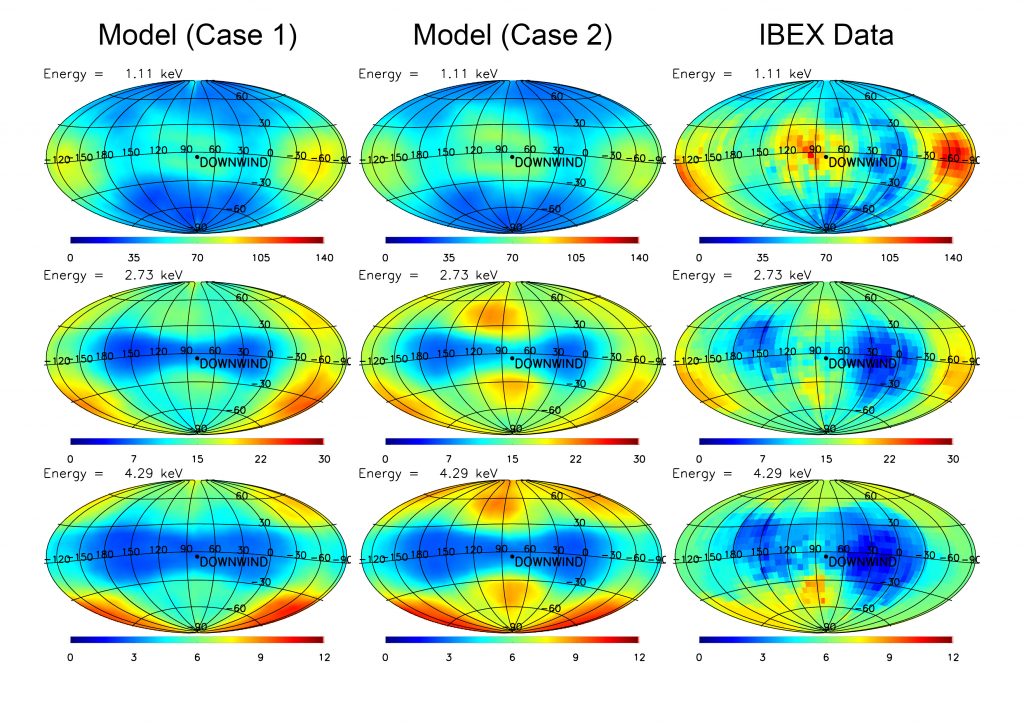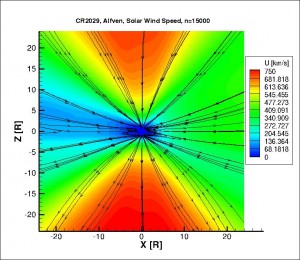My current research interests focus on the global structure of the heliosphere. The heliosphere plays an important role in filtering out high energy particles from entering the solar system. The heliosphere is formed by the interaction of the solar wind with the interstellar medium, and I am working with Prof. Merav Opher at BU as part of the SHIELD Drive Center to better understand the shape of the heliosphere.
Current Work
My current work is based upon understanding the heliosphere through energetic neutral atoms (ENAs). Aside from the Voyager spacecraft, which only give two lines-of-sight in the heliosphere, there is no way to directly probe the structure of the heliosphere; however, it can be probed indirectly via ENAs. The Interstellar Boundary Explorer (IBEX) is currently making ENA maps of the heliosphere, which have provided crucial information on the contents of the heliosphere. Since ENAs can only indirectly probe the structure of the heliosphere, we need to create simulated ENA maps of heliospheric models to compare with the observations in order to truly understand the structure. Classically, the heliosphere is regarded as having a quiescent, comet-like tail which can extend for thousands of AU. Recently, Opher et al. (2015) suggested this may not be the case, and the tail of the heliosphere may actually look more like a croissant, with two turbulent lobes which create a much shorter tail than the classical view. An important element of the “croissant” heliosphere is that the solar magnetic field is able to confine the solar wind. I study the heliosphere through the lens of ENAs, and some of my past work has focused on how the confinement of the solar wind by the solar magnetic field can be seen via ENA observations (Kornbleuth et al. 2018, 2020).
One focus of my research has been to understand the structure of the heliosphere’s tail, and to determine methods for evaluating if it is long or short. In Kornbleuth et al. (2021a,2021b) I compared simulations of a short and long tail heliosphere to determine if any differences could be discerned in terms of the heliospheric properties or through their ENA emissions. My team and I found that given current observational limitations, the question remains open, but I am currently investigating other avenues for evaluating the true shape of the heliosphere.


My past work, conducted at the Harvard-Smithsonian Center for Astrophysics, focused on studying solar wind charge exchange in the vicinity of Earth. As solar wind ions interact with neutral hydrogen around the Earth, an electron gets exchanged at a high energy level, which will then lose energy and cause the emission of an X-ray photon. The photons are visible in observations from the Chandra X-ray Observatory, and so studying the X-ray background of Chandra observations and comparing these data with solar wind observations and modeling yielded insight into the significance of the X-ray background produced from solar wind charge exchange.
During my undergraduate at BU, I worked on a project which involved studying the mass loss rates of stars. As stars give off a wind, they are ejecting some of their mass. While this is a small fraction of the overall mass of a star, some winds can be significant enough that considerable mass gets lost from a star. My work focused on using simulations of the Sun and an M dwarf star to reveal how using different models to drive winds will affect the resultant mass loss rates. The first model that I used incorporates Alfven wave damping in the corona to drive winds. The other was a semi-empirical heating model that focuses on using a thermal driving mechanism to create winds. These models were both run with the Space Weather Modeling Framework (SWMF) developed at the University of Michigan.



Your researchment is very interesting for me. I say good luck to you